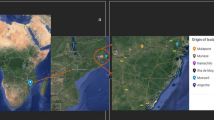Abstract
The aim of this work is to study the genetic diversity and the symbiotic effectiveness of the natural populations of rhizobia nodulating chickpea (Cicer arietinum L.) in six locations of South Tunisia, where chickpea had never been cultivated. Nodules were observed only in the two soil samples from Gafsa (0.8 nodules per plant) and Tataouine (2 nodules per plant). PCR-RFLP typing of 165 rRNA genes of 42 isolates indicated that all analysed strains showed the same ribotype as the reference strainSinorhizobium meliloti RCR2011. These isolates induced ineffective nodules on chickpea andMedicago sativa; however nodules onMedicago laciniata were effective. Analysis of the symbiotic diversity by PCR-RFLP, of thenifDK spacer suggested that all chickpea isolates from the South belong to the biovarmedicaginis ofS. meliloti. The present paper is, to our knowledge, the first report showing that chickpea is selectively nodulated under soil conditions by a specific biovar ofS. meliloti showing specificity toM. laciniata. The specificity of this interaction as well the impact of this inefficient nodulation on chickpea cultivation needs to be investigated further.
Similar content being viewed by others
References
Amarger N., Macheret V., Laguerre G. (1997).Rhizobium gallicum sp. nov. andRhizobium giardinii sp. nov. fromPhaseolus vulgaris nodules. Int. J. Syst. Bacteriol., 47: 996–1006.
Aouani M.E., Mhamdi R., Jebara M., Amarger N. (2001). Characterisation of rhizobia nodulating chickpea in Tunisia. Agronomie, 21: 577–581.
Ben Romdhane S., Nasr H., Samba-Mbaye R., Neyra M., Ghorbal M.H. (2005). Diversity ofAcacia tortilis rhizobia revealed by PCR/RFLP on crushed root nodules in Tunisia. Ann. Microbiol., 55: 249–258.
Ben Romdhane S., Nasr H., Samba-Mbaye R., Neyra M., Ghorbal M.H., De Lajudie P. (2006). Genetic diversity ofAcacia tortilis ssp.raddiana rhizobia in Tunisia assessed by 16S and 16S-23S rDNA genes analysis. J. Appl. Microbiol., 100: 436–445.
Bromfield E.S.P., Barran L.R. (1990). Promiscuous nodulation ofPhaseolus vulgaris, Macroptilium atropurpureum, andLeucaena leucocephala by indigenousRhizobium meliloti. Can. J. Microbiol., 36: 369–372.
Gao W.M., Yang S.S. (1995). Arhizobium strain that nodulates and fixes nitrogen in association with alfalfa and soybean plants. Microbiology, 141: 1957–1962.
Gaur Y.D., Sen A.N. (1979). Cross inoculation group specificity inCicer-rhizobium symbiosis. New Phytol., 83: 745–754.
Jamann S., Fernandez M.P., Normand P. (1993). Typing method for N2-fixing bacteria based on PCR-RFLP-application to the characterization ofFrankia strains. Mol. Ecol., 2: 17–26.
Jebara M., Mhamdi R., Aouani M.E., Ghrir R., Mars M. (2001). Genetic diversity ofSinorhizobium populations recovered from differentMedicago varieties cultivated in Tunisian soils. Can. J. Microbiol., 47: 139–147.
Jeder H., de Lajudie P., Dreyfus B., Le Floch’s E., Behaeghe T., Zaafouri M. S., Akrimi N. (1996). Etude de la nodulation des légumineuses pastorales autochtones des régions arides de Tunisie. Rev. Arid Regions, 9: 3–10.
Jordan D.C. (1984). Rhizobiaceae. In: Krieg N.R., Holt J.G., Eds, Bergey’s Manual of Systematic Bacteriology, Williams & Wilkins, Baltimore, pp. 234–242.
Khbaya B., Neyra M., Normand P., Zerhari K., Filali-Maltouf A. (1998). Genetic diversity and phylogeny of rhizobia that nodulateAcacia spp. in Morocco assessed by analysis of rRNA genes. Appl. Environ. Microbiol., 64: 4912–4917.
Laguerre G., van Berkum P., Amarger N., Prévost D. (1997). Genetic diversity of rhizobial symbionts isolated from legume species within the generaAstragalus, Oxytropis andOnobrychis. Appl. Environ. Microbiol., 63: 4748–4758.
Laguerre G., Nour S.M., Macheret V., Sanjuan J., Drouin P., Amarger N. (2001). Classification of rhizobia based onnodC andnifH gene analysis reveals a close phylogenetic relationship amongPhaseolus vulgaris symbionts. Microbiology, 147: 981–993.
Laranjo M., Machado J., Young J.P.W., Oliveira S. (2004). High diversity of chickpeaMesorhizobium species isolated in a Portuguese agricultural region, FEMS Microbiol. Ecol., 48: 101–107.
Maatallah J., Berraho E.B., Munoz S., Sanjuan J., Lluch C. (2002). Phenotypic and molecular characterization of chickpea rhizobia isolated from different areas of Morocco. J. Appl. Microbiol., 93: 531–540.
Martinez-Romero E., Caballero-Mellado J. (1996).Rhizobium phylogenies and bacterial genetic diversity. Crit. Rev. Plant Sci., 15: 113–140.
Mhamdi R., Laguerre G., Aouani M.E., Mars M., Amarger N. (2002). Different species and symbiotic genotypes of field rhizobia can nodulatePhaseolus vulgaris in Tunisian soils. FEMS Microbiol. Ecol., 41: 77–84.
Mnasri B., Mrabet M., Laguerre G., Aouani M.E., Mhamdi R. (2007). Salt-tolerant rhizobia isolated from a Tunisian oasis that are highly effective for symbiotic N2-fixation withPhaseolus vulgaris constitute a novel biovar (bv.mediterranense) ofSinorhizobium meliloti. Arch. Microbiol., 187: 79–85.
Nour S.M., Fernandez M.P., Normand P., Cleyet-marel J.C. (1994).Rhizobium ciceri sp. nov., consisting of strains that nodulate chickpea (Cicer arietinum L.). Int. J. Syst. Bacteriol., 44: 511–522.
Nour S.M., Cleyet-Marel J.C., Normand P., Fernandez M.P. (1995). Genomic heterogeneity of strains nodulating chickpeas (Cicer arietinum L.) and description ofRhizobium mediterranium sp. nov. Int. J. Syst. Microbiol., 45: 640–648.
Segovia L., Young J.P.W., Martinez R. (1993). Reclassification of AmericanRhizobium leguminosarum bv.phaseoli type I strains asRhizobium etli sp. nov. Int. J. Syst. Bacteriol., 43: 347–377.
Villegas M.D.C., Rome S., Maure L., Domergue O., Gardan L., Bailly X., Cleyet Marel J.-C., Brunel B. (2006). Nitrogen-fixing sinorhizobia withMedicago laciniata constitute a novel biovar (bv.medicaginis) ofS. meliloti. Syst. Appl. Microbiol., 29: 526–538.
Vincent J.M., Ed. (1970). A Manual for the Practical Study of Root-Nodule Bacteria. IBM Handbook, Vol. 15, Blackwell Scientific publications, Oxford.
Weisburg W.G., Barns S.M., Pelletier D.A., Lane D.J. (1991). 16S ribosomal DNA amplification for phylogenetic study. J. Bacteriol., 173: 697–703.
Zahran H.H. (2001). Rhizobia from wild legumes: diversity, taxonomy, ecology, nitroge fixation and biotechnology. J. Biotechnol., 91: 143–153.
Zakhia F., Jeder H., Domergue O., Willems A., Cleyet-Marel J.-C., Gillis M., Dreyfus B., De Lajudie P. (2004). Characterisation of wild lequme nodulating bacteria (LNB) in the infra-zone of Tunisia. Syst. Appl. Microbiol., 27: 380–395.
Zribi K., Mhamdi R., Huguet T., Aouani M.E. (2004). Distribution and genetic diversity of rhizobia nodulating natural populations ofMedicago truncatula in Tunisian soils. Soil Biol. Biochem., 36: 903–908.
Author information
Authors and Affiliations
Corresponding author
Rights and permissions
About this article
Cite this article
Romdhane, S.B., Aouani, M.E. & Mhamdi, R. Inefficient nodulation of chickpea (Cicer arietinum L.) in the arid and Saharan climates in Tunisia bySinorhizobium meliloti biovarmedicaginis . Ann. Microbiol. 57, 15–19 (2007). https://doi.org/10.1007/BF03175044
Received:
Issue Date:
DOI: https://doi.org/10.1007/BF03175044




